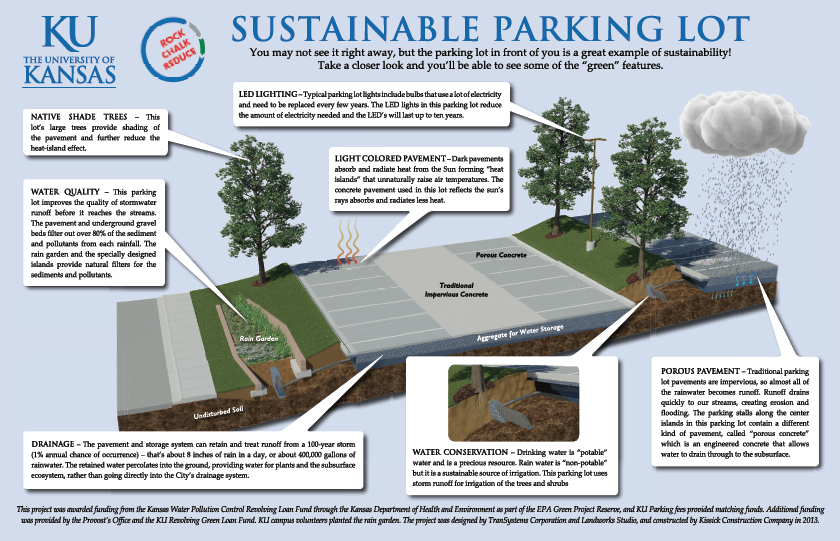Campus Projects

Student Rain Garden
The Rain Garden is 5,200 square feet and is home to 2,500 native plants from up to 18 different species. It has two terraces that are bounded by large cut lime stones. A rain garden is a planted depression that allows rainwater runoff the opportunity to be absorbed from impervious urban areas like roofs, sidewalks and driveways. Water from the rooftop of the new addition to the Student Recreation Center will be distributed along the garden, reducing the flow rate and allowing for infiltration, where the plants will clean the pollutants to improve water quality from the impervious surfaces. The water will then be filtered back into the water table and not into the sewer system. The garden will be self sustaining and the native plants will be able to survive with no fertilizers or pesticides and little to no maintenance.
Mission
The Student Rain Garden is to encourage student involvement on campus. Students can greatly impact the university to make a personal connection to the school and make it a better place for future students. This project is to be considered a pilot project for sustainable landscaping and storm water management plans. The garden will only use native plants and this will promote bio-diversity in the local ecology. The garden is sited in front of the new addition to the Student Recreation Center. This is a high traffic site and will raise awareness of social and environmental issues, while encouraging students to get involved in projects and progressive changes within the University.
History
Students from multiple disciplines worked together from the initial concept to the final planting to design the first KU campus rain garden. After a few years and an extraordinary effort, six students along with the Emerging Green Builders student organization completely implemented the project:
- Laura Foster, Architecture, Ferguson, MO
- John Kenny, Civil and Environmental Engineer, Leavenworth, KS
- England Porter, Environmental Studies, Independence, KS
- Studie Red Corn, Civil and Environmental Engineering
- Neil Steiner, Architectural Engineering, Tulsa, OK
- Callie Statz, Architectural Engineering, Ballwin, MO
These students began with researching about rain gardens, picking a site, and designing a storm water management plan. They were involved in the complete process including meetings with Construction Management and the engineers, construction drawings, bid sets, plant lists, and more. This project was possible because of the enthusiasm of the students and the university staff eager to implement an innovative storm water management plan on a large scale for the university. The KU Rain Garden was entirely a student effort.
Sustainable Parking Lot
KU's first sustainable parking lot, Lot 54, contains a number of features that contribute to environmentally-friendly land use and grounds-keeping on campus, including:
- Native shade trees and the intentional use of light colored pavement keep the surface of the lot and the air around it cooler by shading from and reflecting the sun's rays.
- Porous pavement allows rainwater to drain through its surface, recharging groundwater storage and irrigating tree roots, rather than being carried rapidly away by traditional impervious pavement.
- Rain gardens collect runoff water, naturally filtering sediment and pollutants collected on the landscape before the rainwater enters the watershed.
Lot 54 is located off of Naismith Dr. between 15th St. and Irving Hill Rd.

Green Features of a Sustainable Parking Lot
Native Shade Trees — This parking lot's large trees provide shading of the pavement and further reduce the heat-island effect.
LED Lighting — Typical parking lot lights include bulbs that use a lot of electricity and need to be replaced every few years. The LED lights in this parking lot reduce the amount of electricity needed and the LEDs will last up to 10 years.
Light-colored Pavement — Dark pavements absorb and radiate heat from the sun, forming "heat islands" that unnaturally raise air temperatures. The concrete pavement used in this lot reflects the sun's rays and absorbs and radiates less heat.
Porous Pavement — Traditional lot pavements are impervious, so almost all of the rainwater becomes runoff, which drains quickly to our streams, creating erosion and flooding. The parking stalls along the center islands in this parking lot contain a different kind of pavement, called "porous concrete," which is an engineered concrete that allows water to drain through to the subsurface.
Water Quality — This parking lot improves the quality of storm water runoff before it reaches the streams. The pavement and underground gravel beds filter out over 80% of the sediment and pollutants from each rainfall. The rain garden the specially designed islands provide natural filters for the sediments and pollutants.
Drainage — The pavement and storage system can retain and treat runoff from a 100-year storm (1% annual chance of occurrence). That's about 8 inches of rain in a day or 400,000 gallons of rainwater. The retained water percolates into the ground, providing water for plants and the subsurface ecosystem rather than going directly into the city's drainage system.
Water Conservation — Drinking water is "potable" water and is a precious resource. Rain water is "non-potable" but it is a sustainable source of irrigation. This parking lot uses storm runoff for irrigation of the trees and shrubs.